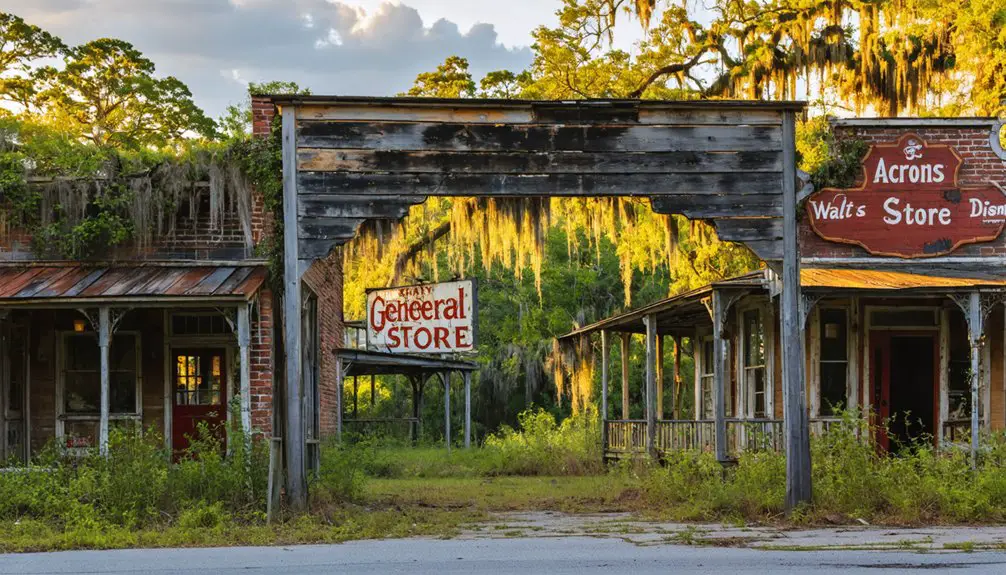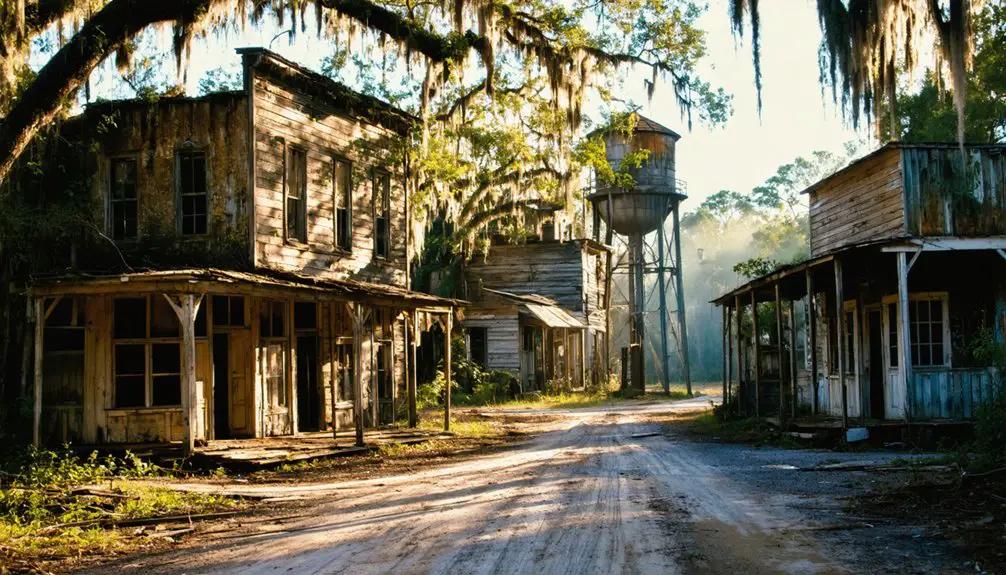You’ll find Acron’s remains in eastern Lake County, Florida, where it flourished briefly as a farming settlement in the late 1800s. The community grew from 30 to 300 residents, centered around Lake Akron and the Campbell family’s post office-hotel. Walt Disney’s parents, Elias and Flora, lived there until 1889, when crop failures forced them to leave. After the devastating Great Freeze of 1894-1895, Acron gradually declined until its post office closed in 1910, leaving behind fascinating archaeological traces.
Key Takeaways
- Acron was a late 1800s settlement near Lake Akron in eastern Lake County, Florida, founded by pioneering families including Campbell and Disney.
- The community peaked at 300 residents, centered around farming, citrus groves, and the Campbell home which served as post office and hotel.
- Flora Call, Walt Disney’s mother, taught at Acron School before marrying Elias Disney and briefly settling in the community.
- The Great Freeze of 1894-1895 devastated local citrus crops, triggering an economic decline that led to families abandoning their homesteads.
- The post office closure in 1910 marked Acron’s final decline, and nature eventually reclaimed the land, leaving only archaeological remnants today.
The Birth of a Rural Settlement
As settlers ventured into eastern Lake County during the late 1800s, they established the rural community of Acron near the pristine waters of Lake Akron. The settlement origins can be traced to the 1860s when pioneering families carved out homesteads in this untamed region of Florida, roughly 40 miles north of where Disney World now stands.
You’ll find that these early settlers were drawn to Acron’s promising location near the southern edge of the Ocala National Forest. They embraced a rural lifestyle centered around farming and citrus cultivation, while a local sawmill provided both employment and materials for construction. Like the ancient Greek physician who used large fires during plague, the townspeople would often burn controlled fires to clear land for agriculture. Maintaining reliable database connections was not a concern for these early residents, unlike modern communities that depend heavily on technology.
As families put down roots, the population grew from about 30 initial settlers to approximately 300 residents, transforming this wilderness into a thriving agricultural community.
Early Pioneers and Community Development
When pioneer families first settled in Acron during the 1870s, the Campbell, Lever, Perkins, Blecha, and Clark families formed the backbone of this emerging community.
You’ll find their pioneer resilience reflected in John C. Campbell’s multiple roles as postmaster and hotel operator, establishing Acron’s first post office in 1877. The community’s identity took shape around the Campbell home, which served as both post office and hotel until 1910.
The settlement grew from 30 to 300 residents, with notable arrivals including Flora Call, Walt Disney’s mother, who became Acron School’s second teacher. The town’s steady growth made it one of Florida’s notable ghost towns by the 1920s.
These early settlers created a close-knit community where the schoolhouse doubled as a church and Masonic meeting place, demonstrating their resourcefulness in building a thriving rural society. The two-story log schoolhouse, established in 1875, became the heart of community life.
Agricultural Legacy and Economic Growth
You’ll find that Acron’s early agricultural growth mirrored patterns seen across Florida, as pioneer farmers experimented with crops like cotton, tobacco, and vegetables while adapting to the region’s challenging climate.
The arrival of the Florida East Coast Railroad in the 1890s transformed the area’s farming potential, enabling faster transport of perishable crops to northern markets and spurring the development of local mills. Early farmers could earn up to $480 per acre when successfully shipping their produce to northern markets.
Local farmers diversified their operations by incorporating citrus groves and implementing new farming methods supported by agricultural institutions like the Florida Farm Bureau. In 1941, the establishment of the Florida Farm Bureau Federation provided crucial support for the region’s agricultural development through legislative representation and marketing improvements.
Citrus Industry Impact
During the early 1800s, Florida’s citrus industry transformed from modest beginnings into a commercial powerhouse, starting with the establishment of notable groves on Merritt Island along the Indian River in 1818.
Citrus cultivation quickly spread, with Leesburg emerging as the first major hub by 1860, where you’d see fruit hauled up to 60 miles by horse, wagon, or boat. The Baer and Campbell company pioneered nationwide distribution by packing and shipping fruit to diverse markets.
The introduction of refrigerated railcars in 1866 revolutionized the industry, allowing you to ship your citrus to northern markets. New groves flourished in areas like Marion and Citra, creating significant economic opportunities.
This economic transformation drove production from one million boxes to over five million by 1893.
Despite devastating setbacks like the Great Freezes of 1835 and 1894-95, the industry adapted by moving southward, eventually reaching unprecedented growth of 100 million boxes annually by 1950.
Pioneer Farming Methods
Beyond the citrus boom, early settlers in South Florida developed diverse agricultural practices that shaped the region’s farming legacy.
You’ll find their pioneering techniques were influenced by Seminole knowledge, particularly in processing coontie root and harvesting palmetto hearts. These settlers transformed the landscape through innovative drainage systems and soil management, establishing profitable truck farming operations. Resourceful farmers relied on local edible plants for sustenance, gathering wild berries and greens to supplement their crops.
Similar to the successful development of the Temple orange tree, these early agricultural innovations laid the foundation for Florida’s thriving farming industry.
- They cleared hardwood trees and used the ashes to enrich muck soils for tomato cultivation.
- They constructed canals to drain swamps, revealing fertile soil beneath.
- They practiced crop rotation with pineapples, pumpkins, coconuts, and vegetables.
- They integrated livestock, allowing branded pigs to forage freely while raising chickens and cattle.
As transportation improved, these farming methods evolved from pure subsistence to commercial operations, with packinghouses and railroad depots facilitating regional distribution of their produce.
Mill Operations Growth
As Florida’s agricultural industry expanded in the early 19th century, mill operations emerged as essential economic engines throughout the region.
You’d find these early mills powered by water, processing everything from lumber to textiles.
Mill technology evolved rapidly, with operations like the Forsyth and Simpson Arcadia Mill producing over 900,000 board feet of lumber annually by the late 1830s.
The Disney Family Connection

You’ll find an intriguing connection between Acron and the Disney family through Elias Disney‘s marriage to Flora Call on January 1, 1888, in nearby Kismet.
The newlyweds settled in Acron, where Flora worked as a teacher while Elias attempted to establish a citrus growing operation.
Their stay proved brief, as crop failures and illness forced the couple to relocate to Chicago in 1889, yet their presence marked the beginning of the Disney family’s historical ties to the region where Walt Disney World would later be built.
Early Marriage Location
While many know Walt Disney‘s later connection to Florida through his theme parks, the Disney family’s ties to the state began much earlier when Elias Disney and Flora Call married on January 1, 1888, in a small church at Kismet.
This marriage significance marked the union of two pioneering families who’d settled in the Lake County area to escape harsh Kansas winters.
- The church stood in Kismet, a now-vanished settlement near Paisley
- The Call family homestead sat about a mile north of Paisley
- The newlyweds first lived in Daytona Beach, where their son Herbert was born
- After Flora’s father died in 1890, they relocated to Chicago
These family origins in Florida created a historical foundation that would later influence Walt Disney’s decision to build his entertainment empire in the Sunshine State.
Disney Family Settlement Years
Two pioneering families, the Disneys and Calls, established deep roots in Central Florida when Kepple and Elias Disney moved to Acron in 1884.
After leaving Kansas’s harsh winters behind, they joined a small farming community of just seven families, totaling around 30 residents. Elias Disney owned five acres where he pursued orange and vegetable farming while taking on additional work as a carpenter and rural mail carrier.
You’ll find that the Disney family’s settlement years were marked by both promise and challenges.
While Elias found his bride Flora Call there in 1888, he also faced setbacks when frost destroyed his orange crop. He later contracted malaria, which, combined with their financial struggles, led the family to relocate to Chicago in 1889, though they maintained their Florida connections through generations.
Life Around Lake Akron
Located in eastern Lake County, Florida, Lake Akron served as the centerpiece for a small but vibrant farming community in the late 19th and early 20th centuries. The lake’s ecology thrived within the region’s karst landscape, surrounded by cypress trees and influenced by seasonal rains.
You’d find about 30 residents, mostly farmers and grove owners, working the fertile soil and tending to orange groves.
- Crystal-clear waters reflected the two-story log building that served as the heart of community gatherings.
- Orange trees dotted the rolling hills, including Elias Disney’s five-acre grove.
- Cypress trees lined the shoreline, their knees emerging from the water’s edge.
- Local children learned their lessons in the same building where adults worshipped and voted.
The tight-knit community balanced farming life with social activities, making the most of their shared spaces around Lake Akron.
The Post Office Era and Communication

As Acron’s population grew from 30 to 300 residents in the late 1800s, the establishment of a post office in 1877 marked a pivotal moment for the frontier community.
John C. Campbell, who served as the first postmaster, operated the postal communication center from his home, which doubled as a local hotel.
You’d find the post office functioning as more than just a mail stop – it was a true community hub where settlers gathered, conducted business, and maintained crucial connections with the outside world.
Despite challenging access via $6 steamer fare and mule cart travel, the post office provided essential services for sawmill, gristmill, farming, and citrus families.
The post office’s prominence continued until 1910, when the demolition of Campbell’s home signaled the beginning of Acron’s decline into ghost town status.
Decline and Abandonment
While Acron’s early prosperity promised a bright future, the devastating Great Freeze of 1894-1895 triggered the town’s gradual descent into abandonment.
The freeze destroyed citrus crops and crippled the local economy, setting off a chain of economic factors that would prove insurmountable. With limited industry beyond agriculture, the town couldn’t recover from this blow, and population trends showed a steady decline as residents sought opportunities elsewhere.
- You’d have witnessed families packing up their belongings, leaving their homesteads behind.
- You’d have seen the post office’s closure, marking the end of essential services.
- You’d have noticed abandoned structures slowly deteriorating in the harsh Florida environment.
- You’d have observed nature reclaiming the land as vegetation overtook the former settlement.
Today, only archaeological remnants tell the story of Acron’s existence.
Geographic Significance Through Time

Through its strategic positioning in eastern Lake County, Acron’s geographic significance evolved dramatically from the 1860s onward.
You’ll find the settlement was initially chosen for its prime location near Lake Akron and essential waterways, enabling necessary transportation via the St. Johns River steamers from Jacksonville to Hawkinsville.
The area’s natural features supported thriving sawmills, gristmills, and citrus groves, while its position allowed for the establishment of significant community infrastructure.
Acron’s rich landscape fostered industrial growth through its mills and groves, laying the groundwork for a promising settlement.
However, geographic isolation began to shape Acron’s destiny as transportation evolved beyond waterways.
While modern visitors can access the ghost town via County Road 42, you’ll discover that Acron’s once-strategic location couldn’t overcome the changing dynamics of Florida’s development, particularly as newer transportation networks bypassed the community.
Historical Impact on Lake County
Since its establishment in the 1860s, Acron emerged as an essential contributor to Lake County’s early development, starting with just 30 residents before growing to nearly 300.
The town’s cultural heritage shaped the region’s community identity through several notable developments:
- The establishment of sawmills and gristmills created crucial economic foundations for Lake County’s industrial growth.
- The Acron School, built in 1875, served as a multi-purpose hub for education, worship, and community gatherings.
- Regular steamer connections to Jacksonville via Hawkinsville integrated the area into broader trade networks.
- The presence of prominent families like the Disneys, including Flora Call Disney who taught at Acron School, connected the town to significant American cultural figures.
Though now a ghost town, Acron’s influence on Lake County’s development remains historically significant.
Frequently Asked Questions
Are There Any Remaining Structures or Ruins Visible in Acron Today?
You won’t find any remaining buildings in Acron today. While historical artifacts lie buried beneath sandy soil, the site is completely barren with only overgrown trails marking where structures once stood.
What Natural Disasters or Events Contributed to Acron’s Eventual Abandonment?
Like a leaf falling from a dying tree, you won’t find hurricane damage or major disasters behind Acron’s demise. Economic decline and poor transportation slowly drained the town’s liveliness over decades.
How Many People Lived in Acron During Its Peak Population?
You’ll find that during peak demographics, Acron reached between 200-300 residents, with most historical significance records pointing to approximately 300 people during its most active period in the late 1800s.
Did Any Famous Residents Besides the Disney Family Live in Acron?
No, you won’t find any other famous residents or local legends in Acron’s history. Historical records show only pioneer families and the Disney connection, with Flora Call Disney being the town’s most notable resident.
What Happened to the Original Land Titles of Acron’s Properties?
Like scattered puzzle pieces, you’ll find the original land ownership records dissolved through time, with titles likely reverting to Lake County control through abandonment or unpaid taxes, though some title disputes remain unclear.
References
- https://kids.kiddle.co/Acron
- https://en.wikipedia.org/wiki/Acron
- https://www.youtube.com/watch?v=Yz6LwBUXCfk
- https://www.youtube.com/watch?v=bx7eU14uI24
- https://www.ghosttowns.com/states/fl/acron.html
- https://urbexunderground.com/ghost-towns-in-florida/
- https://www.florida-backroads-travel.com/florida-ghost-towns.html
- https://floridatrailblazer.com/2015/07/
- https://ecommons.cornell.edu/bitstream/1813/54886/1/FLORIDA_ESSAY.pdf
- https://pbchistory.org/a-story-of-agriculture/



